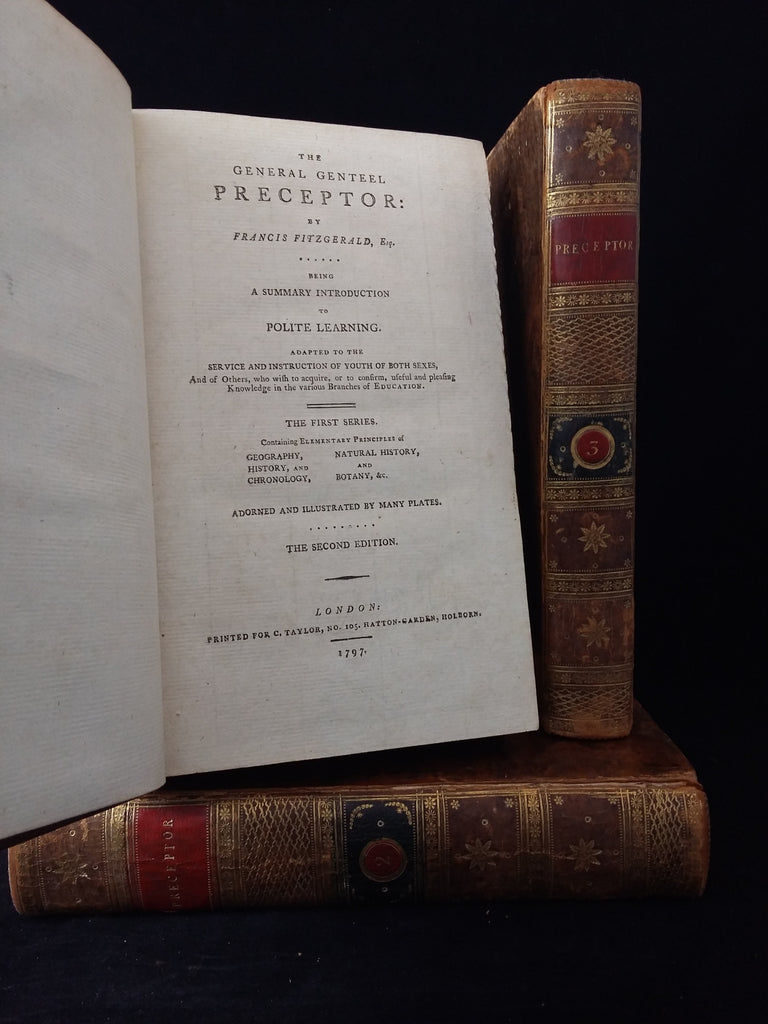The General Genteel Preceptor
FITZGERALD, Francis






Being a summary introduction to Polite Learning adapted to the Service and Instruction of Youth of Both Sexes, and of Others, who wish to acquire, or to confirm, useful and pleasing Knowledge in the various Branches of Education. The First Series. Containing Elementary Principles of Geography, History and Chronology, Natural History, and Botany &c. Adorned and Illustrated by Many Plates.
London: Printed for C. Taylor. 1797.
Second edition. Three Volumes. 8vo in 4s (210x125mm). pp. Vol. I. pt. I: xiv, [2], 242, [2]; pt. II: [iv], 208; Vol. II. pt. III. Divisions 1, 2 & 3: [ii], 440; Division 4 [ii], viii, 79. Vol. III. Pt. IV; [iv], 96, Pt VI; 33-224 [1], Pt V; [ii], 1-32 (see below for explanation). Mottled calf, edges decorated in gilt. Spine decorated in gilt with contrasting lettering pieces in red (title in gilt) and green (volume number in gilt on a contrasting red circle). Some shelfwear and rubbing, particularly to the hinges which are cracking in places although sound. Some slight scuffing to the upper and lower covers of volume III. Edges sprinkled green. The contents are in excellent condition (save where noted below) with no significant, marking or foxing. All three volumes are profusely illustrated with charming and fascinating engravings of the subject matter. The plates are fine and the fifteen folding maps in volume I are in excellent condition with many of them outlined in colour. The only major flaw is on page 79 of part IV of Volume II (i.e. the very last page) which has been repaired following a tear to the bottom corner but there is some loss to the text. Ownership inscription of Eleanor Clarke in each volume. It is rare to find The General Preceptor complete with all its parts and plates present and this is a particularly good set although (as explained) there are eccentricities in the pagination.
Volume I contains Part I (Geography) and Part II (History and Chronology). Volume II contains Part III (Natural History) which is split into four divisions, each with its own title page: Beasts, Birds, Fish and Insects. The first three divisions are paginated continuously from 1-440. The title page for Insects is then followed by the index for the preceding three sections, and then the text for "Insects" is paginated 1-79 but with its index inserted at pp 75/76. Despite this confusion, the signatures and pagination are complete. Volume III has even more eccentricities but, again, is complete. It contains Part IV (Botany), Part V (The Arts of Drawing and Architecture) and Part VI which is divided into two parts - the Elements and the Senses. There is a section on Astronomy (confusingly also referred to as Part VI but presumably this should read "VII" as the pagination and the signatures follow on from Part VI). Part V which is paginated 1-33 has been incorrectly bound after Part VI and so comes right at the end. In a way, this is understandable as Drawing and Architecture seem to sit apart from the other subjects dealt with in this volume. However, the binder has clearly gone against his instructions. Although this is a wonderfully informative set with the most extraordinarily ambitious range of knowledge on display, in places it does appear that the binder has been in a rush. But, as this is an encyclopaedia it does not, perhaps, matter (and it is rather charming for it adds to the eccentricity of the whole project) because everything that should be here is here. A hugely entertaining and educational work, impossible to summarise, delightful to dip into. If you want to know what genteel young people were expected to know in the late 18th century (and it was a lot), you will find it here.
